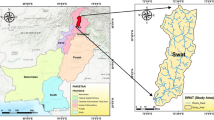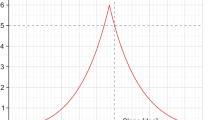Abstract
The environmental consequences are defined as consequences of accidental release of hazardous substances to the natural environment. This release can lead to many hazards depending on the material stored. The consequences of these hazards to the environment are widespread and have significant importance to human communities living in the surroundings. The mathematical models are extremely useful tools to predict the impacts of chemical process accidents. The objective of this paper is to develop a software package for accident simulation and damage potential estimation. The software is coded in visual basic and is compatible with windows working environments. The software is called Simulation of chemical industrial accident. This application is a comprehensive software package which can be integrated with geographical information system to predict and display the consequence of chemical hazards. The software is a user-friendly and effective tool for evaluating the consequences of major chemical accidents, process decision making for land-use planning, namely locating suitable hazardous installations, hazardous waste disposal areas and emergency response plan.
Similar content being viewed by others
References
Andereassen, M.; Bakken, B.; Danielsen, U.; Haanes, H.; Solum, G.; Stenssas, J.; Thon, H.; Wighus, R., (1992). Handbook for fire calculations and fire risk assessment in the process industry. Scandpower A/S.
Andersson, P., (1997). Evaluation and mitigation of industrial fire hazards. ISRN LUTVDG/TVBB-1015-SE. Lund University Sweden.
Ashe, B.; Rew, P. J., (2003). Effects of flashfires on building occupants. Health and Safety Executive. Prepared by WS Atkins Consultants Ltd.
Babrauskas, V., (1983). Estimating large pool fire burning rates. Fire Tech., 19, 251–261.
Baker, E.; Cox, A.; Westine, S.; Kulez, J.; Strehlow, A., (1983). Explosion hazards and evaluation. Elsevier, New York.
Baum, R., (1998). Rocket missiles generated by failure of a high pressure liquid storage vessel. J. Loss Prevent Proc. 11, 11–24.
Birk, M., (1995). Boiling liquid expanding vapour explosion Response and Prevention: Technical Documentation.
BIS (2003). BLEVE incident simulator. ThermDyne Technologies Ltd with the help of Professor A. M. Birk, Queen’s University.
Brasie, W.; Simpson, W., (1968). Guidelines for estimating damage explosion. J. Loss. Prevent. Proc., 2, 91.
Brown, S., (1986). Energy release protection for pressurized systems. Part II review of studies into impact/terminal ballistics. Appl. Mechani. Rev., 39, 177–201.
Burgess, D.; Hertzberg, M., (1974). Radiation from pool flames, heat transfer in flames, Afgan, N. H and Beer, J. M. Eds, John Wiley, New York.
CCPS (1994). Guidelines for chemical process quantitative risk analysis. Center for chemical process safety of the American Institute of Chemical Engineering, New York.
Clancey, V., (1972). Diagnostic features of explosion damage, in: Proc. Sixth Int. Meeting of Forensic Sciences, Edinburgh.
CPQRA (2000). Guidelines for chemical process quantitative risk analysis (2nd. Ed.).Chemical process quantitative risk analysis, American Institute of Chemical Engineers, New York.
Cuchi, E.; Casal, J., (1998). Modeling temperature evolution in equipment engulfed in a pool-fire. Fire Safety J., 30, 251–268.
DiNenno, P.; Drysdale, D.; Beyler, C.; Walton, W.; Custer, R.; Hall, J.; Watts, J., (2002). The STPE handbook of fire protection engineering. National Fire Protection Association, Inc. USA.
EFFECT (1987). Model for computing the physical effects of the escape of hazard materials (TNO, The Netherland).
Eisenberg, N.; Lynch, C.; Breeding, R., (1975). Vulnerability model: A simulation system for assessing damage resulting from marine Spills. Rep. CG-D-136-75. Environment Control Inc., Rockville, MD.
ERM (1996). Consequence analysis. Seminar on control of industrial major accident hazards regulations. Hotel Equatorial, Kuala Lumpur, Malaysia.
ESRI (2004). ArcGIS engine developer guide. The user guide for ArcGIS Engine. Environmental Systems Research Institute Published by ESRI: www.esri.com.
FRED, (2004). Fire, Release, Explosion and Dispersion, Shell software (Shell Global Solutions).
Fugelso, L.; Wenner, L.; Schiffman, T., (1972). Explosion effects computation aids. GARD Prog. 1540. Gen. Am. Res. Div., Gen. Am. Transportation Co., Niles, IL.
Hanna, S., (1982). Applications in air pollution modeling. In Nieuwstadt, F. T. M. and van Dop, H., Reidel Publishing Co., Dordrecht, The Netherland.
Hardee, H.; Lee, D.; Benedick, W., (1978). Thermal hazards from LNG fireballs. Combust. Sci. Tech., 17, 189.
Holden, P.; Reeves, A., (1985). Fragmentation hazards from failures of pressurized liquefied gas vessels. Assessment and control of major hazards. IChemE Symposium Series # 93 IChemE, Rugby, UK. 205–220.
Howerton., A., (1969). Estimating the area affected by a chlorine release. J. Loss. Prevent. Proc., 3, 48.
Hymes, I., (1 983). The physiological and pathological effects of thermal radiation. SRD.
Kashef, A.; Bénichou, N.; Torv, D.; Raboud, D.; Hadjisophocleous, G.; Reid, I., (2002). FIERAsystem enclosed pool fire development model: Theory report. Fire risk management program, Institute for Research in Construction (IRC), National Research Council Canada.
Kent, R., (1968). Find radiation effect of flares. Hydrocarb. Proc., 47(6), 119.
Khan, F.; Abbasi, S., (1998). MAXCRED-a new software package for rapid risk assessment in chemical process industries. Environ. Modell. Softw., 14, 11–25.
Khan, F.; Abbasi, S., (1999). HAZDIG: a new software package for assessing the risks of accidental release of toxic chemicals. J. Loss. Prevent. Proc., 12, 167–181.
Kim, D.; Lee, Y.; Moon, I.; Lee, Y.; Yoon, D., (2001). Automatic accident scenario generation for petrochemical processes. Process System Engineering ESCAPE: 895–900.
Kinsman, P.; Wilday, J.; Nussey, C.; Mercer, A., (1994). Users’ views of model performance and expectations. J. Loss. Prevent. Proc., 7, 2, 66–200.
Kletz, T., (1988). Process plants: a handbook for inherently safer design. Taylor and Francis.
Lees, F., (1996). Loss prevention in the process industries, 2nd. edn., Butterworth-Heinemann, Boston, Massachusetts.
Moore, V., (1967). The design of barricades for hazardous pressure system. Nucl. Eng. Des., 5, 1550–1566.
Moorhouse, J., (1982). Scaling laws for pool fires determined from large scale experiments. IChemE Symposium series, 71, 165–179.
Papazoglou, A.; Aneziris, N., (1999). Uncertainty quantification in the health consequences of the boiling liquid expanding vapour explosion phenomenon. J. Hazard. Mater. A67, 217–235.
Pasquill, F.; Smith, F., (1983). Atmospheric diffusion, 3rd. Ed. New York: Wiley.
Perry, R.; Green, D., (1984). Perry’s chemical engineering handbook, 6th. Ed. McGraw Hill, New York.
Petrolekasa, P.; Andreoub, I., (1999). Domino effects analysis for the LPG storage installation of hellenic petroleum aspropyrgos refinery. Proceedings of seveso 2000 European Conference. http://mahbsrv.jrc.it/Proceedings/Greece-Nov-1999/C3-ANDREOU-z.pdf
Pietersen, M., (1984). Analysis of the LPG incident in San Juan Ixhumtepec, Mexico City, Rep. 85-0222. TNO, Apeldoorn, The Netherland.
Rew, P.; Hulbert, W., (1996). Development of pool fire thermal radiation model. Health and safety executive, HSE contract research report # 96/1996.
Roberts, B., (1982). Thermal radiation hazards from release of LPG from pressurized storage. Fire Safety J., 4, 197–212.
Simmons, J.; Erdmann, R.; Naft, B., (1973). The risk of ctastrophic spill of toxic chemicals. Rep. UCLA-ENG-7425. Unv. of California, Los Angeles, California.
Solomon, A.; Rubin, M.; Okrent, D., (1976). On risks from the storage of hazardous chemicals. Universty of California, Los Angeles.
Technica Ltd. (1985). Manual of industrial hazards assessment London, WHAZAN.
Ten Berge, W.; Van Heemst, M., (1983). Validity and accuracy of commonly used toxicity assessment models in risk analysis, 4th hit. Symp. Loss Prevent., Harrogate.
TNMA (2001). Estimation of Explosion Danger Areas. Technical Note 10.20/01.
TNO (1990). Methods for the determination of the possible damage to humans and goods by the release of hazardous materials (Green Book). The hague: Dutch ministry of housing, Physical Planning and Environment.
Tsao, C.; Perry, W., (1979). Modifications to the vulnerability model: A simulation system for assessing damage resulting from marine spills (VM4). ADA 075 231, US Coast Guard NTIS Report No. CG-D-38-79.
UIC (1987). Emission a ‘la bre’che d’une capacité-débit en phase gazeuse, débit en phase liquide, Union des Industries Chimiques, formation et vaporisation des flaques. Cahier de sécurité # 1, Edition Chimie Promotion, Paris.
Wiekema, B. J., (1980). Vapour cloud explosion model. J. Hazar. Mater., 3, 221–232.
Withers, J.; Lees, P., (1985). The assessment of major hazards: the lethal toxicity of chlorine. Part 1, Review of information on toxicity. J. Hazard. Mater., 12(3), 231.
Zhang, Q.; Miao, C.; Lin, D.; Bai, C., (2003). Relation of fragment with air shock wave intensity for explosion in a shell. Int. J. Impact Eng., 28, 1129–1141.
Author information
Authors and Affiliations
Corresponding author
Rights and permissions
About this article
Cite this article
El Harbawi, M., Mustapha, S., Choong, T.S.Y. et al. Rapid analysis of risk assessment using developed simulation of chemical industrial accidents software package. Int. J. Environ. Sci. Technol. 5, 53–64 (2008). https://doi.org/10.1007/BF03325997
Received:
Revised:
Accepted:
Published:
Issue Date:
DOI: https://doi.org/10.1007/BF03325997




